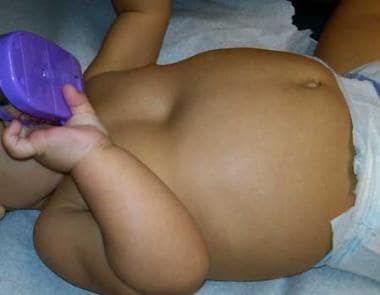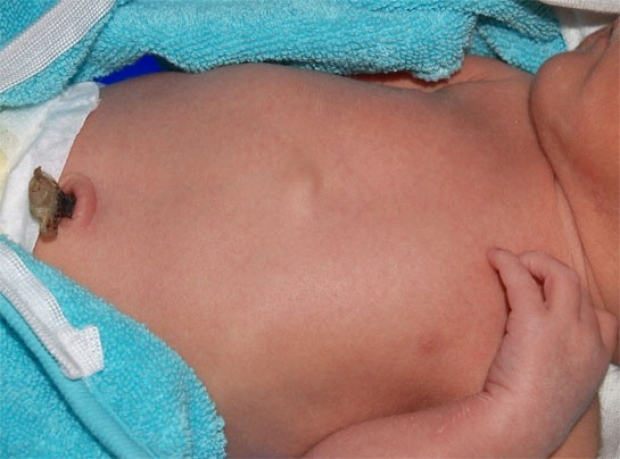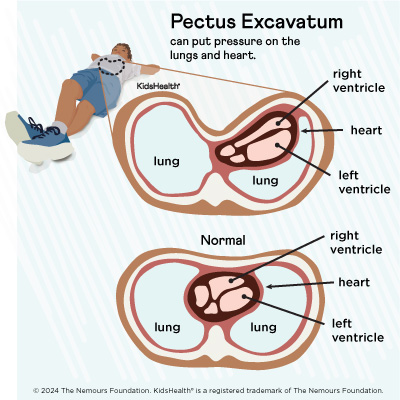pectus excavatum baby causes
It is caused when several ribs and the sternum grow abnormally which produces a caved-in or sunken appearance of the chest. Luckily there can be many symptoms that can be an indicator to seek medical help.

Nuss Procedure For Pectus Excavatum Background Indications Contraindications
It surrounds and protects the heart and lungs.

. The deformity can become more visible as your child grows up especially during puberty. What is pectus excavatum. The chest wall is made up of bones as well as muscle and other tissue.
Pectus excavatum a deformity of the sternum and ribs caused by an unbalanced costochondral hypertrophy is a congenital abnormality with a prevalence of 1 per 1000 patients. The condition affects more boys than girls. The condition is sometimes called concave chest or funnel chest.
It is more common in boys than girls. A child with pectus excavatum usually has a depression in the center of the chest over the breastbone which may appear quite deep. This causes a depression in the chest that can range from mild to severe.
The condition is not always noticeable at birth but is often apparent by the time a child is 2 to 3. This makes it much harder for parents to recognize the problem. The condition is also called sunken.
While this can be noted early in life pediatric pectus excavatum often worsens during a growth spurt in adolescence. Pectus excavatum PECK-tuss ex-kuh-VAW-tum is a condition that causes a childs chest to look sunken or caved in It happens because of a defect in the tough connective tissue cartilage that holds the bony part of the ribs to the breastbone. Brown butter oatmeal cookies sallys baking addiction Under.
The breastbone or sternum and some of the ribs grow abnormally causing a depression in the middle of the chest. It can also develop in a baby after birth. The patient delivered a 3100 g male baby during the 39 th week of gestation by cesarean section with an Apgar score of 910.
It can present in toddlers but typically becomes apparent during the growth spurt and puberty. Pectus excavatum also known as concave chest or funnel chest is a deformity of your childs chest wall. This causes a depression of the sternum and the chest has a sunken in or funnel chest appearance.
While most patients do not have symptoms those with severe. What is a pectus excavatum. At age 14 that he had the genetic condition known as pectus excavatum which causes the breastbone to sink into the chest sometimes dramatically.
With pectus excavatum the sternum goes inward to. One of the symptoms may be if your baby is crying very often for no particular reason. Pectus excavatum PEK-tus eks-kuh-VAY-tum is a deformity of the chest wall that causes several ribs and the breastbone sternum to grow abnormally giving the chest a concave or caved-in appearance.
Pectus excavatum is usually congenital present at. It occurs mostly in boys and frequently more members in a family are affected. Commonly called funnel chest pectus excavatum is a depression caused when the sternum breastbone is abnormally pushed inward.
Ultrasonographic images of pectus excavatum a Axial thoracic section pectus severity index is calculated by the ratio of the lateral diameter of the chest to the distance between the sternum and spine at the point. Amongst doctors dealing with pectus excavatum there is a lot of discussion. I was in junior high a time when your.
Medical information and health advice you can trust. Pectus excavatum is caused by the abnormal growth in the chest of the connective tissues cartilage that attach the breastbone sternum to the ribs. Pectus excavatum is a structural deformity of the anterior thoracic wall in which.
Pectus excavatum is a congenital deformity of the chest wall that causes several ribs and the breastbone sternum to grow in an inward direction. Pectus excavatum is a condition in which the breastbone is sunken into the chest. 13 Most Common Causes of Pectus Carinatum Deformity.
Pectus excavatum is a condition in which instead of being level with the ribs the breastbone sternum is sunken so that the middle of the chest looks caved in. The most common chest wall deformity pectus excavatum or sunken chest is most likely caused by abnormal growth of the costal cartilage junction between the ribs and sternum. Pectus excavatum sometimes called cobblers chest sunken chest or funnel chest is the most common chest deformity affecting between 1 in 300 and 1 in 500 adolescents.
Pectus excavatum is a congenital chest wall deformity that is caused by growth abnormality of the cartilage that connects the ribs to the breastbone sternum. Many doctors think the problem is caused by the cartilage that joins the ribs to the breastbone. Both or just one side of the breastbone may be affected.
Pectus excavatum is a relatively common congenital deformity a defect that is present at birth in which the chest appears sunken. This information from Great Ormond Street Hospital GOSH is about pectus excavatum also known as funnel chest. If kids are born with pectus excavatum it might not be noticeable at first.
The breastbone is out of its normal position because the cartilage in the ribs develops more quickly than the bones. The severity of this condition can range from mild to severe. The depression in the chest is due to abnormal growth of the cartilage that attaches the sternum to the ribs.
Symptoms of Pectus Excavatum in Kids. The cartilage pushes the breastbone sternum inward. Pectus excavatum is an abnormal development of the rib cage in which the sternum breastbone grows inward resulting in a noticeable and sometimes severe indentation of the chest wall.
Also known as sunken chest or funnel chest pectus excavatum can be corrected with the minimally invasive surgical technique called the Nuss. This is sometimes called sunken or funnel chest. Because of the deep depression the lower ribs can stick out and give the appearance of a potbelly in.
1 2 Pectus excavatum may be associated with connective tissue disorders such as Marfan and. Usually the ribs and sternum go outward at the front of the chest. There is no known cause for pectus excavatum.
Pectus excavatum affects about one in.

Newborn Care Chest And Abdomen Philadelphia Fight

Features Of Rickets Such A Frontal Bossing Harrison Sulcus Pectus Download Scientific Diagram

Fighting Like A Girl Phoenix Children S Hospital

Marfan Syndrome What To Know Marfan Syndrome Alport Syndrome Syndrome

Lungs Chest Newborn Nursery Stanford Medicine

Pectus Excavatum Symptoms Treatments And Complications

Pectus Excavatum October 2017 Babies Forums What To Expect

I Was Born With Pectus Excavatum My Sternum Bone Was Fused To My Back Bone So In This Picture Mine I Pectus Excavatum Enough Is Enough Stainless Steel Wire

Pectus Excavatum And Improve Your Homoeopathic Knowledge Facebook
How To Deal With Your Child S Pectus Carinatum Condition Align Clinic

Anyone Familiar With This Issue December 2016 Babies Forums What To Expect

Chest Wall Disorder Pectus Excavatum For Parents Primary Children S Hospital


